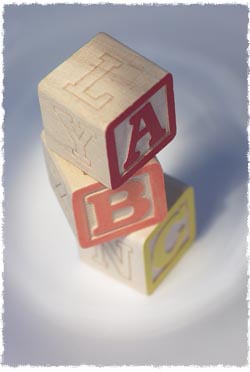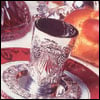a) Leave work early Friday afternoon so you have time to prepare for Shabbat at home.
b) Clean the home in honor of the Shabbat queen.
c) Cook the Shabbat meals well in advance of Shabbat. Set up the blech that will keep the food warm for the Shabbat meals.
d) Set the Shabbat dinner table with: Candles and candlesticks, two whole loaves of challah placed on a tray and covered with a cloth, a cup or goblet and wine for kiddush; and the fanciest tableware you own.
e) Bathe or shower and dress in formal attire
f) Light Shabbat candles 18 minutes before sunset. Click here for the exact time in your location.
g) From this point until Shabbat's end (step v) refrain from all "work" as defined by the laws of Shabbat.
h) Pray the special Shabbat evening service (preferably in your synagogue) including the L'cha Dodi song — "Come, my beloved, to greet the bride, let us receive the presence of the Shabbat..."
i) Gather around the dinner table and sing Shalom Aleichem (welcome to the Shabbat angels). Then sing "A Woman of Valor" (Proverbs 31) composed by King Solomon as a tribute to the Jewish woman.
j) Pour a cup of kosher wine or grape juice into a special goblet and recite the Kiddush that proclaims the sanctity of the Shabbat.
k) Go to the kitchen sink and do the washing-the-hands ritual done before eating bread: fill a large cup with water and pour water onto each of your hands three times and recite the appropriate blessing.
l) Return to the table, recite the blessing over the challah, slice it up, dip it in salt, eat some and pass around challah slices to everyone.
m) Serve the Shabbat meal. The traditional Friday night menu includes gefilte fish (or some other kind of fish) chicken soup with matzo balls or noodles, a chicken or meat entree with side dishes (traditional choices are kugel and tzimmes), and desert.
n) Between courses, sing the traditional shabbat songs (zemirot) and discuss Parshah (Torah reading) of the week and its relevance. Printing the Chabad.org Parshah PDF before Shabbat will give you much fodder for conversation. At the meal's end, recite the Grace after Meals.
o) If it's not too late, now's the perfect time for some quality time with family and/or friends, to do some Torah learning or read a Jewish book.
p) Go to sleep and enjoy the unique pleasure of Shabbat rest.
q) In the morning, walk to shul (don’t bike/blade/drive) for the morning services and the Torah reading. (If you're lucky, there'll be a kiddush buffet after services!)
r) Return home and sit down to a Shabbat meal. The daytime meal follows the same basic structure as yesterday evening's — kiddush (the daytime version), ritual washing, blessing on two challah loaves, delicious food. Traditional foods for the daytime meal include egg salad with onions and the mythical Shabbat cholent — a slow-cooking stew that sits on a small covered flame from before Shabbat. Don't forget the singing, stimulating discussion and Grace after Meals.
s) Shabbat afternoon naps are delicious; reserve some time also to do some learning and reading, or to attend a Torah class (if there's one within walking distance).
t) Later in the afternoon, recite the minchah afternoon prayers; in the summer, this is followed with the study of a chapter from Ethics of the Fathers.
u) Eat the Third Meal, a light repast served between minchah and maariv.
v) Approximately an hour after sundown, after it gets dark, Shabbat is over. Click here for the exact time in your location. Recite the evening prayers.
w) Now it's time for Havdalah, the separation ritual performed with an overflowing cup of wine, spice box and braided candle.
x) There's one more meal: Melaveh Malkah ("Farewell to the Queen"), a light meal accompanied with songs about Elijah the Prophet and stories about the righteous.
y) Re-enter the work-week revitalized with the spiritual energy and vision gained from Shabbat.
z) Repeat next week.
(Easy, no?)







Join the Discussion